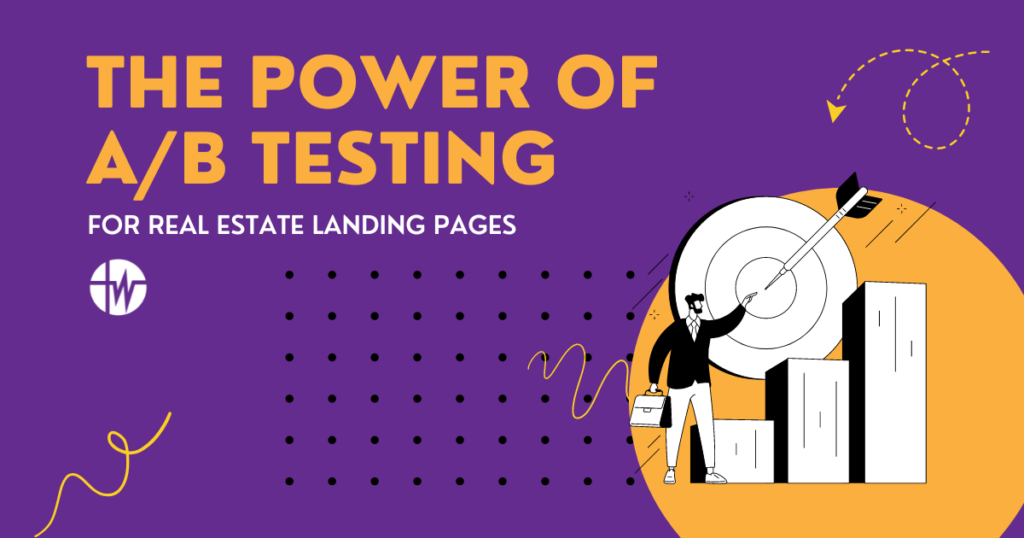A/B testing for real estate landing pages is a powerful tool that can help optimize customer engagement and generate more leads. With A/B testing, you can compare landing pages side-by-side to determine which elements are most effective at turning visitors into customers. This article will discuss the benefits of A/B testing, including increased website performance, improved user experience, and maximized customer reach. It will also explore strategies for implementing effective A/B tests and the steps required to ensure success.
By leveraging insights gained through A/B testing, businesses can unlock potential revenue opportunities while providing customers with an engaging web presence tailored to their preferences. Are you ready to launch an A/B test on your real estate website? Here’s everything you need to know first!
What is A/B Testing?
A/B testing, also known as split testing, is the long-trusted scientific process of comparing two landing page variations to see which one is most effective. It involves designing multiple versions of the same page to test how changes in design impact user engagement and conversion rate.
As an innovative tool for real estate SEO, A/B testing provides agents with invaluable insights into what works best when crafting webpages that drive customer action and satisfaction. This information helps shape effective strategies to boost click-through rates and conversions while ensuring users have a positive experience on the site.
Why Do Real Estate Landing Pages Need A/B Testing?
In addition to improving aspects of technical SEO, A/B testing can tell real estate agents a lot about their market and target audience. The results of this testing strategy demonstrate which types of listings get the most attention and which pricing strategies attract buyers. Moreover, agents can use A/B testing to move traffic toward social media channels, build a database of qualified buyers/sellers, or develop an audience for their email marketing campaigns.
How To Set Up An A/B Test
Setting up an A/B test requires careful planning and execution, but it can be done in just a few steps. By following the protocols used for controlled experiments, businesses can quickly optimize page performance and maximize conversions.
The first step in setting up an A/B test is deciding which elements must be tested on your landing page. This could include anything from text formatting or headline size to title tags and meta descriptions or images. Most importantly, each page needs a call-to-action item. Call-to-action items can be listing links, a contact field, or a social media follow button.
Once these elements are identified, you’ll want to create two versions of your landing page, one as the control (A) and another with the changes that will be tested against it (B). You’ll then set up A/B testing tools such as Google Analytics or HotJar to track each version’s performance accurately over time.
After launching the test, you should monitor how users interact with both versions until you get statistically significant results showing which variation performs better. You want to see which page gets more interaction with its call-to-action item.
Once you have collected enough data, you must analyze it carefully before implementing permanent changes based on what was learned during testing. To ensure accurate results, try running multiple tests simultaneously using different variations so that all potential factors influencing user behavior are considered.
What Types Of Elements Should I Consider Testing On A Real Estate Landing Page?
When considering what elements to test for a real estate landing page, it is important to consider visuals, property images, home page layout, listing descriptions, and call-to-action items.
Home page layouts should be tested to ensure that users have a pleasant navigation experience while browsing listings on the site. Listing descriptions should be analyzed to maximize relevancy and accuracy so potential buyers clearly understand the properties. Finally, calls-to-action must be optimized, so visitors are encouraged to take further steps towards converting into leads or sales.
Analyzing Results & Making Changes
Now that the A/B test has been set up, it is time to analyze the results and make changes. Several metrics need to be monitored to gain a comprehensive view of how visitors interact with each page variant.
- Conversion rate – Measuring which version had more sales or leads generated.
- Reversion rate – Tracking when users return after clicking away from landing pages.
- Bounce rate – Calculating what percentage of people left immediately after arriving on the page.
- Time spent on site – Gauging user engagement by measuring the average time spent on landing pages.
- Clicks per Page Element – Examining where users clicked most often and whether one variation performed better than another in terms of clicks.
These metrics will reveal how effective certain elements were for conversions, such as call-to-action buttons, images, copy length, and organic vs PPC acquisition, providing insight into what works best for different audiences.
Common Mistakes To Avoid
A/B testing for real estate landing pages can be a goldmine of insights if done correctly, but it is easy to fall into the common traps that leave marketers with less than helpful results. To help ensure successful outcomes, here are some key points to remember when creating your A/B tests.
First, avoid sampling errors by running experiments on target audiences that don’t accurately represent the entire population you’re trying to reach. If possible, test multiple versions at once instead of just two to get more reliable data and account for overlapping goals between different segments.
Second, ensure that you measure the correct metrics and not just click-through rates; look deeper at user behaviors and build insights related to your real estate goals. As you interpret the results carefully, don’t forget to check what could have caused any unexpected findings.
Finally, don’t forget to make changes! Raw data alone is only valuable when you apply it to the final version of your website. Use each landing page’s strengths and weaknesses to create something fully optimized, well-rounded, and sure to stand out during your next SEO audit.
Tools Available For A/B Testing
The best A/B testing tools will allow users to make informed decisions about their online marketing campaigns and maximize the effectiveness of each page. An array of platforms are available for running experiments on real estate websites, from open source solutions like Google Optimize to more sophisticated A/B testing platforms such as KISSmetrics or VWO.
With these tools, it becomes easier to measure performance metrics such as click-through rate (CTR), time spent on a page, conversion rate, and more. These types of analytics are crucial in understanding how visitors interact with your website and what changes need to be made to improve user engagement and ultimately increase profits.
Types of A/B Testing Software:
- Optimizely
- AB Tasty
- Freshmarketer
- The HubSpot A/B Testing Kit
- Adobe Target
Frequently Asked Questions
What Is The Difference Between A/B And Multivariate Testing?
A/B testing and multivariate testing are two different ways to test out different versions of a web page. Generally speaking, A/B tests involve creating two variants of the same webpage to measure which performs best. Alternatively, multivariate testing involves creating multiple combinations of variations on multiple elements within an individual page instead of completely separate pages.
It is often beneficial for real estate landing pages to use both experiments depending on your goals. If you want to optimize a single variable, running an A/B test quickly is likely the most efficient option. Running a multivariate test will yield better results if you’re trying to understand how various elements interact together.
How Long Should An A/B Test Typically Run?
As any content specialist knows, there’s no single answer. When determining the duration of an A/B test, consider the following:
- how reliable and significant do you want your results to be
- the size of your audience
- the amount of traffic hitting your page
Running an A/B test for at least two weeks will give you enough time to gather meaningful data to help inform decisions about improving conversions or user experience. However, this timeframe may vary depending on the complexity of each test. Some testing cycles could last from days to months to provide accurate insights into customer behavior and preferences.
There are many advantages to longer testing periods as they allow more people to interact with different versions of a page or ad. This gives businesses a better idea of which variations impact their bottom line. These longer tests also offer organizations more flexibility when making changes based on results since they don’t need to worry about short-term fluctuations due to seasonal trends or other external influences.
Are There Any Risks Associated With A/B Testing?
When it comes to A/B testing, several risks should be considered.
- Unanticipated Outcomes – Testing two variations could lead to unanticipated outcomes, which may decrease or damage user engagement.
- Wrong Targeting – Your test results may not be accurate or helpful without proper targeting strategies for specific types of users and their needs.
- Data Loss Risk – If data is collected incorrectly during the test period, it could potentially lead to the loss of valuable insights from the experiment’s findings.
- Limited Feedback – It is difficult to get detailed feedback from users regarding their experiences while taking part in A/B tests since they typically focus on quantitative metrics rather than qualitative ones.
Use A/B Testing to Create Powerful Real Estate Landing Pages
A/B testing is a powerful tool that can be used to optimize real estate landing pages. It allows marketers to identify the elements of a page that are most effective and those that need improvement. Despite its power, it is essential to consider any potential risks associated with A/B testing before launching an experiment. Additionally, there may be limitations due to time or budget constraints and technical issues related to implementation.
Despite these considerations, A/B testing can still provide valuable insights. By taking the time to carefully plan experiments, test different elements on a landing page, and measure the results over time, marketers can maximize the effectiveness of their online presence to drive more conversions from visitors.

 January 3, 2023
January 3, 2023




